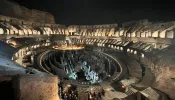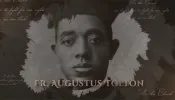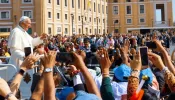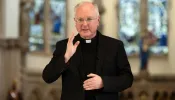Author: Ezekiel
Date: 600-550 BC
Ezekiel is a very challenging book for several reasons. The author uses unfamiliar apocalyptic imagery to describe many things. The historical situation in which Ezekiel wrote is rather complicated and many of the events in the book occur only in visions. Even Ezekiel's geographical location is puzzling. Much of the exacting detail in his visions seems unnecessary.
Ezekiel was a priest and a prophet who was taken from Judah to Babylon in the second wave of exiles (597 BC). His prophecies are very attentive to the Temple, the liturgy and the Sabbath. He takes the ceremonial commands of the law just as seriously as the moral. He calls the exiled people to faithfulness to the Lord even though the signs of the Lord's blessing (the land and the Temple) have been taken away.
Ezekiel's visions are categorized as apocalyptic literature. Daniel, Zechariah and Revelation also contain apocalyptic literature as do several non-canonical books from biblical times. Apocalyptic literature uses a mixture of complex symbols to talk about catastrophic events in the future. Each of Ezekiel's visions serves as a window into the spiritual life of Judah and its relationship with God. He has a vision of heaven (1-3), of idolatry in the Temple and the glory of the Lord leaving the Temple (8-10), of the valley of the dry bones (37), and of the New Temple and the restored land with God's glory returning (40-48). The lengthy final vision of a restored Israel with all of its precise measurements envisions a nation of God's people living in God's order but its details are open to many interpretations.
Like Jeremiah, Ezekiel performs some dramatic prophetic acts. These acts serve as visual aids to Ezekiel's prophetic message from the Lord. Most of Ezekiel's prophetic acts anticipate the Lord's judgment on Judah. The Lord commands Ezekiel to make miniature models of the imminent siege of Jerusalem and to lie on his side, eating rationed bread (4). Then the Lord tells Ezekiel to cut his hair and do various things with the clippings as a metaphor for Israel's coming punishment (5). Later he performs a mock exile from his tent and eats with anxiety to pre-figure the exile of Judah (12). To symbolize the re-unification of Israel and Judah, Ezekiel ties two sticks together (37).
Scholars debate exactly where Ezekiel was located during his ministry. Ezekiel seems to be transported by God a few times, but it is not exactly clear if the "transports" are physical or visionary (see 8:3, 11:24, 43:5). The most likely proposals suggest he was located in Babylon from 597 onward, but had several visions in which he saw events in Judah.
Like the other prophets, Ezekiel has a message of judgment and a message of restoration. He announces God's judgment against Judah for its sins against the covenant and he pronounces God's judgment against the surrounding nations which oppressed Judah. When Ezekiel upbraids Judah for its gross infidelity to the Lord, some of the language he uses is so strong that it startles us by its harshness. Yet Ezekiel does not leave his hearers in a state of condemnation, but invites them to turn away from their sins and take advantage of God's promises and covenant. Though the Lord uses Ezekiel to chide the people, he also uses him to give hope to his suffering people in a time of exile and persecution. Ezekiel is a prophet of judgment and a prophet of renewal.
By Mark Giszczak











